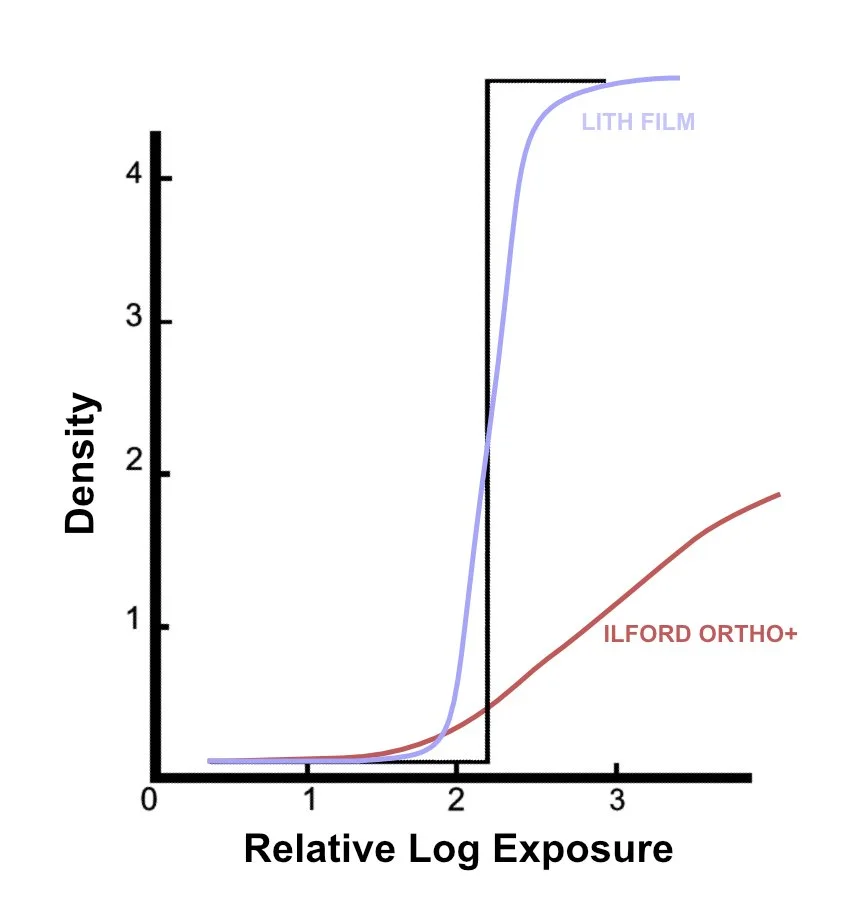low contrast ortho-litho processing, PART I
Using Ortho-Litho Film for Pictorial Photography: An Affordable Approach to Managing High Contrast
Ortho-litho film, known for its high contrast and low-cost, has long been a challenging choice for ultra-large-format photographers looking to explore creative applications. This film, traditionally used for graphic arts, is available at a fraction of the cost of standard black-and-white film. For instance, a box of 50 sheets of 20x24 ortho-litho film is priced around $199, compared to the $1299 for 25 sheets of Ilford HP5 or FP4. However, its high contrast—a key feature for print application—presents challenges when repurposed for pictorial photography. While photographers have experimented with various techniques to manage this contrast, one simple solution offers a breakthrough. In this article I will discuss ortho-litho film, it’s composition, how it gets its notoriously high contrast and how to tame the gradient curve.
Understanding Ortho-Litho Film’s High Contrast
Ortho-litho films, sometimes called graphic arts or line films, were originally created to support high-resolution print applications. With a strong focus on professional print applications, for use in creating plates for offset printing, these films were required to provide extreme, sharp contrast essential for clear, well-defined lines and dot screens. To understand how this is achieved in a silver halide film, we need to understand how developers affect contrast.
pH and Film Development
An ideal step function curve (black) with the characteristic curve of a lith film and a normal contrast pictorial orthochromatic film, Ilford Ortho+.
Standard hydroquinone and metol based film developers are only active in alkaline solutions. This is the reason a stop bath consists of acetic acid: the acidic environment stops all development. The activity of a given developer formula, that is, its ability to reduce a latent image to metallic silver, increases as the pH increases. This is achieved by utilizing progressively more alkaline compounds in the developer. Normal contrast, pictorial developers, such as D-76, utilize mild alkalis, such as borax, sodium carbonate or sodium sulfite for a pH about 8.5. This is perfect for pictorial films, because we are trying to get continuous tone images, with clear separation of values and a gentle gradation from black to white.
Lith developers, on the other hand, are trying to achieve little or no gradation at all, with a step function as the ideal contrast range. To do this, they utilize powerful alkalis such as sodium or potassium hydroxide to adjust pH to 10.5, about 100 times more alkaline. Most importantly, lith films incorporate an accelerator, a chemical incorporated within the film’s emulsion itself—often pyrazolo [3,4-d] pyrimidine or similar compounds—which produces rapid, uncontrolled development and an exceptionally high density maximum (dMax). This is known as “infectious development”, and it occurs even when using lower contrast, standard developers when such accelerants are present. While invaluable for lithographic purposes, infectious development hinders the film’s adaptability for in-camera, low-contrast pictorial photography.
Common Techniques to Control Contrast in Ortho-Litho Film
Photographers keen on repurposing ortho-litho films have typically relied on heavily diluted developers and other techniques in an attempt to reign in this extreme contrast. Experiments with PMK, D-76 and others utilize extremely short development times, 1-3 minutes, with varied results. Even extended dynamic range, ultra low-contrast developers like POTA, which was used to photograph atomic explosions, are difficult to control. As a result, photographers end with continuous tone images, but with transparent, streaky blacks and persistent high contrast. Some have tried flashing techniques—briefly exposing the film to controlled light—or chemical flashing, to increase speed and improve usability, utilizing additives like PFS-4 (formulated by Ashley Houston at https://grainy.vision/blog/ortho-litho-reference), all aimed at helping contrast. However, these approaches still share the same difficulties in process control and contrast, because we are battling the effects of the accelerator and infectious development.
A Simple and Cost-Effective Solution: The Sodium Sulfite Pre-Wash
The breakthrough solution for controlling contrast in ortho-litho film is surprisingly straight forward: a 2-5 minute pre-wash in a 5% solution of anhydrous sodium sulfite. I learned this process from legendary Vancouver photochemist, Jack Beatty, and it transformed my utilization of ortho-litho film for continuous tone applications. Sodium sulfite is an inexpensive and readily available chemical, priced around $2 per liter of 5% solution, and works by effectively neutralizing the infectious development process: it dissolves the accelerants out of the film’s emulsion, allowing the film to respond more predictably to normal contrast developers and creates a manageable contrast range ideal for in-camera work and internegatives. As a result, photographers can harness the unique qualities of ortho-litho film for pictorial applications predictably and cheaply without battling uncontrollable contrast.
With this pre-bath, I am able to utilize a standard film developer, such as D-76, at normal dilution (stock or 1:1) for more conventional render times. This results in better consistency and fewer processing artefacts, and a more pleasing tonal range. Due to the orthochromatic sensitivity of ortho-litho film, development can be done by inspection.
IN THE SECOND PART IN THIS SERIES, WE’LL SHOW RESULTS FROM USING LITH FILM IN THE FIELD WITH THE RITTER 20x24 CAMERA

